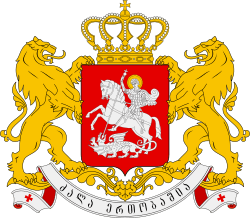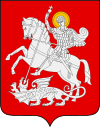Georgian Soviet Socialist Republic
The Georgian Soviet Socialist Republic (Georgian SSR; Georgian: საქართველოს საბჭოთა სოციალისტური რესპუბლიკა, translit.: sakartvelos sabch'ota sotsialist'uri resp'ublik'a; Russian: Грузинская Советская Социалистическая Республика, romanized: Gruzinskaya Sovetskaya Sotsialisticheskaya Respublika) was one of the republics of the Soviet Union from its inception in 1922 to its breakup in 1991. Coterminous with the present-day republic of Georgia, it was based on the traditional territory of Georgia, which had existed as a series of independent states in the Caucasus prior to annexation by the Russian Empire in 1801. The Georgian SSR was formed in 1921 and subsequently incorporated in the Soviet Union in 1922. Until 1936 it was a part of the Transcaucasian Socialist Federative Soviet Republic, which existed as a union republic within the USSR. From November 18, 1989, the Georgian SSR declared its sovereignty over Soviet laws. The republic was renamed the Republic of Georgia on November 14, 1990, and subsequently became independent before the dissolution of the Soviet Union on April 9, 1991, whereupon each former SSR became a sovereign state.
Georgian Soviet Socialist Republic | |||||||||||
|---|---|---|---|---|---|---|---|---|---|---|---|
| 1921–1991 | |||||||||||
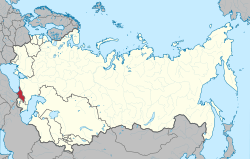 Location of Georgia (red) within the Soviet Union | |||||||||||
| Status | Independent state (1921–1922) Part of the Transcaucasian SFSR (1922–1936) Soviet Socialist Republic (1936–1991) | ||||||||||
| Capital | Tbilisi | ||||||||||
| Common languages | Georgian Russian Abkhaza Ossetianb Mingrelian Svan | ||||||||||
| Government |
| ||||||||||
| Leader | |||||||||||
• 1921–1922 | Mamia Orakhelashvili (first) | ||||||||||
• 1989–1990 | Givi Gumbaridze (last) | ||||||||||
| Head of state | |||||||||||
• 1990–1991 | Zviad Gamsakhurdia (last) | ||||||||||
| Premier | |||||||||||
• 1922 | Polikarp Mdivani (first) | ||||||||||
• 1990–1991 | Tengiz Sigua (last) | ||||||||||
| Legislature | Supreme Soviet | ||||||||||
| History | |||||||||||
| 11 February 1921 | |||||||||||
• Formation | 25 February 1921 | ||||||||||
| 30 December 1922 | |||||||||||
• TSFSR dissolved | 5 December 1936 | ||||||||||
• Sovereignty declared | 18 November 1989 | ||||||||||
• Renamed to Republic of Georgia | 18 November 1990 | ||||||||||
| 9 April 1991 | |||||||||||
• Independence recognized | 26 December 1991 | ||||||||||
| Area | |||||||||||
| 1989 | 69,700 km2 (26,900 sq mi) | ||||||||||
| Population | |||||||||||
• 1926 | 2,666,000 | ||||||||||
• 1989 | 5,400,841 | ||||||||||
| Currency | Soviet ruble (руб) (SUR) | ||||||||||
| Calling code | 7 881/882/883 | ||||||||||
| |||||||||||
| Today part of | |||||||||||
| |||||||||||

Geographically, the Georgian SSR was bordered by Turkey to the south-west and the Black Sea to the west. Within the Soviet Union it bordered the Russian SFSR to the north, the Armenian SSR to the south and the Azerbaijan SSR to the south-east.
History
Establishment
On November 28, 1917, after the October Revolution in Russia, there was a Transcaucasian Commissariat established in Tiflis. On April 22 the Transcaucasian Democratic Federative Republic was formed, though it only lasted for a month before being replaced by three new states: the Georgian Democratic Republic, the First Republic of Armenia and the Azerbaijan Democratic Republic. The 1919 parliamentary elections saw the Social Democratic Party come to power in Georgia. It tried to establish a moderate left, multi-party system, but faced some internal and external problems. Georgia was dragged into wars against Armenia and remnants of the Ottoman Empire, while the rapid spread of ideas of revolutionary socialism in rural regions accounted for some Soviet-backed peasants' revolts in Racha, Samegrelo and Dusheti. In 1921, the crisis came to a head. 11th Red Army invaded Georgia from south and headed to Tbilisi. On 25 February, after a one-week offence by the Red Army, Tbilisi fell to the Bolsheviks.[1] Georgian Bolsheviks took over the country and proclaimed the establishment of the Georgian SSR. Some small-scale battles between Bolshevik troops and Georgian Army also took place in Western Georgia. In March 1921 the government of the Georgian Democratic Republic was forced in exile. On March 2 of the following year the first constitution of Soviet Georgia was accepted.
On 13 October 1921 the Treaty of Kars was signed, which established the common borders between Turkey and the three Transcaucasian republics of the Soviet Union. Georgian SSR was forced to cede Georgian-dominated Artvin Okrug to Turkey in exchange for Adjara, which was granted political autonomy within Georgian SSR under Soviet rule.
Transcaucasian Soviet Federated Socialist Republics
.jpg)
In 1922 the Georgian SSR was incorporated into Soviet Union. From March 12, 1922, to December 5, 1936, it was part of the Transcaucasian SFSR together with the Armenian SSR and the Azerbaijan SSR. During this period the province was led by Lavrentiy Beria, the first secretary of the Georgian Central Committee of the Communist Party of Georgia.[2] In 1936, the TSFSR was dissolved and Georgia became the Georgian Soviet Socialist Republic.
Lavrentiy Beria became head of the Georgian branch of the Joint State Political Directorate (OGPU) and was transferred to Moscow in 1938.
Purges
The exact number of Georgians executed during the Great Purges is not estimated, but some scholars suggest it varies from 30,000 to 60,000. During the purges, many eminent Georgian intellectuals such as Mikheil Javakhishvili, Evgeni Mikeladze, Vakhtang Kotetishvili, Paolo Iashvili, Titsian Tabidze and Dimitri Shevardnadze were executed or sent to the Gulag. Party officials also suffered the purges. Many prominent Georgian Bolsheviks, such as Mikheil Kakhiani, Mamia Orakhelashvili, Sergo Ordzhonikidze, Budu Mdivani, Mikheil Okujava and Samson Mamulia were removed from office and killed.
World War II
Reaching the Caucasus oilfields was one of the main objectives of Adolf Hitler's invasion of the USSR in June 1941, but the armies of the Axis powers never reached as far as Georgia. The country contributed almost 700,000 fighters (350,000 were killed) to the Red Army, and was a vital source of textiles and munitions. During this period Joseph Stalin (an ethnic Georgian) ordered the deportation of the Chechen, Ingush, Karachay and the Balkarian peoples from the Northern Caucasus; they were transported to Siberia and Central Asia for alleged collaboration with the Nazis. He abolished their respective autonomous republics. The Georgian SSR was briefly granted some of their territory until 1957.[3]
Post-Stalin period

On March 9, 1956, about a hundred Georgian students were killed when they demonstrated against Nikita Khrushchev's policy of de-Stalinization that was accompanied by an offhanded remark he made about Georgians at the end of his anti-Stalin speech.
The decentralisation program introduced by Khrushchev in the mid-1950s was soon exploited by Georgian Communist Party officials to build their own regional power base. A thriving pseudo-capitalist shadow economy emerged alongside the official state-owned economy. While the official growth rate of the economy of the Georgia was among the lowest in the USSR, such indicators as savings level, rates of car and house ownership were the highest in the Union,[4] making Georgia one of the most economically successful Soviet republics. Corruption was at a high level. Among all the union republics, Georgia had the highest number of residents with high or special secondary education.[5]
Although corruption was hardly unknown in the Soviet Union, it became so widespread and blatant in Georgia that it came to be an embarrassment to the authorities in Moscow. Eduard Shevardnadze, the country's interior minister between 1964 and 1972, gained a reputation as a fighter of corruption and engineered the removal of Vasil Mzhavanadze, the corrupt First Secretary of the Georgian Communist Party. Shevardnadze ascended to the post of First Secretary with the blessings of Moscow. He was an effective and able ruler of Georgia from 1972 to 1985, improving the official economy and dismissing hundreds of corrupt officials.
In the 1970s Soviet authorities adopted a new policy of forming a "Soviet people". The "Soviet people" were said to be a "new historical, social, and international community of people having a common territory, economy, and socialist content; a culture that reflected the particularities of multiple nationalities; a federal state; and a common ultimate goal: the construction of communism." The Russian Language was meant to become the common language of this community, considering the role that Russian was playing for the nations and nationalities of the Soviet Union. This policy had its ideological roots in Marxist notion of withering away of the nations. However, in 1978, Soviet authorities had to face the opposition of thousands of Georgians, who gathered in downtown Tbilisi to hold mass demonstration after Soviet officials accepted removal of the constitutional status of the Georgian language as Georgia's official state language. Bowing to pressure from mass street demonstrations on April 14, 1978, Moscow approved Shevardnadze's reinstatement of the constitutional guarantee the same year. April 14 was established as a Day of the Georgian Language. In 1981, massive celebrations took place in honour of the republic's 60th anniversary, with a mass event taking place in front of Chairman Brezhnev on Tbilisi's Constitution Square.[6]
End of the Soviet period
.svg.png)
Shevardnadze's appointment as Soviet Foreign Minister in 1985 brought his replacement in Georgia by Jumber Patiashvili, a conservative and generally ineffective Communist who coped poorly with the challenges of perestroika. Towards the end of the late 1980s, increasingly violent clashes occurred between the Communist authorities, the resurgent Georgian nationalist movement and nationalist movements in Georgia's minority-populated regions (notably South Ossetia). On April 9, 1989, Soviet troops were used to break up a peaceful demonstration at the government building in Tbilisi. Twenty Georgians were killed and hundreds wounded and poisoned. The event radicalised Georgian politics, prompting many – even some Georgian communists – to conclude that independence was preferable to continued Soviet unity and would provide Georgia with a chance to fully integrate both South Ossetia and Abkhazia, whose peoples were still loyal to the Union.
On October 28, 1990, democratic parliamentary elections were held, and on November 15 the nation was renamed the Republic of Georgia. Georgia (excluding Abkhazia) was one of the six republics along with Armenia, Moldova and the Baltic States who boycotted participation in the March 1991 union-wide preservation referendum. It declared independence on April 9, 1991, under Zviad Gamsakhurdia, as one of the republics to secede just four months before the failed coup against Gorbachev in August, which was supported by a declining number of hardliners. However, this was unrecognized by the Soviet government and Georgia was in the Soviet Union until its collapse in December 1991.
Footnotes
- The Europa World Year Book 2004, Volume I. Europa World Year Book (45th ed.). London: Europa Publications. 2004 [1928]. p. 1806. ISBN 1-85743-254-1.
However, Georgia was invaded by Bolshevik troops in early 1921, and a Georgian Soviet Socialist Republic (SSR) was proclaimed on 25 February.
- . Geronti Kikodze (1954) Notes of a Contemporary, first published in 1989, Mnatobi, Issue 1, Tbilisi, Georgia.
- Parrish, Michael (1996). The Lesser Terror: Soviet State Security, 1939-1953. Greenwood Publishing Group. p. 102. ISBN 0-275-95113-8.
- Gregory Grossman, ‘The "Second Economy" of the USSR’, Problems of Communism, vol. 26 no. 5, 1977, quoted from Cornell, Svante E., Autonomy and Conflict: Ethnoterritoriality and Separatism in the South Caucasus – Case in Georgia Archived June 30, 2007, at the Wayback Machine. Department of Peace and Conflict Research, Report No. 61. p. 149. University of Uppsala, ISBN 91-506-1600-5.
- Suny, Ronald G.; James Nichol; Darrell L. Slider (1996). Armenia, Azerbaijan, and Georgia. DIANE Publishing. pp. 186. ISBN 0-7881-2813-2.
Abkhazia.
- https://www.youtube.com/watch?v=9kOR6wIiodY
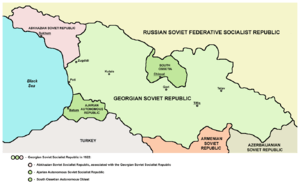 Map of the Georgian & Abkhazian Socialist Soviet Republics in 1922-1931
Map of the Georgian & Abkhazian Socialist Soviet Republics in 1922-1931 Map of the Georgian Soviet Socialist Republic in 1931-1943
Map of the Georgian Soviet Socialist Republic in 1931-1943.jpg) Map of the Georgian Soviet Socialist Republic in 1944-1955
Map of the Georgian Soviet Socialist Republic in 1944-1955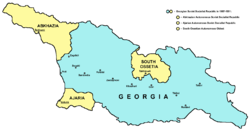 Map of the Georgian Soviet Socialist Republic in 1957-1991
Map of the Georgian Soviet Socialist Republic in 1957-1991
Bibliography
- Cornell, Svante E. (2001), Small Nations and Great Powers: A Study of Ethnopolitical Conflict in the Caucasus, London: Curzon Press, ISBN 978-0-70-071162-8
- Jones, Stephen F. (October 1988), "The Establishment of Soviet Power in Transcaucasia: The Case of Georgia 1921–1928", Soviet Studies, 40 (4): 616–639, doi:10.1080/09668138808411783
- Marshall, Alex (2010), The Caucasus Under Soviet Rule, New York City: Routledge, ISBN 978-0-41-541012-0
- Martin, Terry (2001), The Affirmative Action Empire: Nations and Nationalism in the Soviet Union, 1923–1939, Ithaca, New York: Cornell University Press, ISBN 978-0-80-143813-4
- Rayfield, Donald (2012), Edge of Empires: A History of Georgia, London: Reaktion Books, ISBN 978-1-78-023030-6
- Rayfield, Donald (2004), Stalin and His Hangmen: The Tyrant and Those Who Killed for Him, New York City: Random House, ISBN 978-0-37-575771-6
- Saparov, Arsène (2015), From Conflict to Autonomy in the Caucasus: The Soviet Union and the making of Abkhazia, South Ossetia and Nagorno Karabakh, New York City: Routledge, ISBN 978-0-41-565802-7
- Scott, Erik R. (2016), Familiar Strangers: The Georgian Diaspora and the Evolution of Soviet Empire, Oxford, United Kingdom: Oxford University Press, ISBN 978-0-19-939637-5
- Smith, Jeremy (2013), Red Nations: The Nationalities Experience in and after the USSR, Cambridge, United Kingdom: Cambridge University Press, ISBN 978-0-52-112870-4
- Suny, Ronald Grigor (1994), The Making of the Georgian Nation (Second ed.), Bloomington, Indiana: Indiana University Press, ISBN 978-0-25-320915-3
- Zürcher, Christoph (2007), The Post-Soviet Wars: Rebellion, Ethnic Conflict, and Nationhood in the Caucasus, New York City: New York University Press, ISBN 978-0-81-479709-9
External links
- Georgia, land of the Golden Fleece, reveals its riches a propaganda pamphlet about the GSSR from the 1960s.
- Avalishvili, Levan: "The “Great Terror” of 1937–1938 in Georgia: Between the Two Reports of Lavrentiy Beria" in the Caucasus Analytical Digest No. 22
- Anchabadze, George: "Mass Terror in the USSR: The Story of One Family" in the Caucasus Analytical Digest No. 22
- Georgian museum of Soviet Occupation, Tbilisi.
.svg.png)


